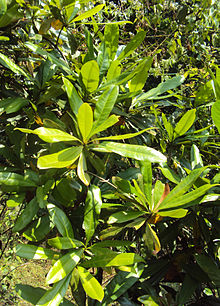This is an old revision of this page, as edited by Vinayaraj (talk | contribs) at 16:25, 16 February 2013. The present address (URL) is a permanent link to this revision, which may differ significantly from the current revision.
Revision as of 16:25, 16 February 2013 by Vinayaraj (talk | contribs)(diff) ← Previous revision | Latest revision (diff) | Newer revision → (diff)
| Ancistrocladaceae | |
|---|---|
| Scientific classification | |
| Kingdom: | Plantae |
| (unranked): | Angiosperms |
| (unranked): | Eudicots |
| (unranked): | Core eudicots |
| Order: | Caryophyllales |
| Family: | Ancistrocladaceae Planch. ex Walp. |
| Genera | |
Ancistrocladaceae is the botanical name for a family of flowering plants. Such a family has been widely recognized by taxonomists.

The APG II system, of 2003 (unchanged from the APG system, of 1998), also recognizes this family and assigns it to the order Caryophyllales in the clade core eudicots. The family consists of a single genus, Ancistrocladus, of about a dozen species of lianas, found in the tropics of the Old World.
Recent molecular and biochemical evidence (see the AP-Website) suggests the carnivorous taxa in the order Caryophyllales (the families Droseraceae and Nepenthaceae and the species Drosophyllum lusitanicum and Triphyophyllum peltatum) all belong to the same clade. This family Ancistrocladaceae would belong to this same clade, although the plants in the family are not carnivorous.
A close relationship between this family and the family Dioncophyllaceae (containing the carnivorous species T. peltatum) is supported by similar pollen and petiole structure. The Cronquist system, 1981, placed the family in the order Violales (together with Dioncophyllaceae). The Takhtajan system placed the family in its own order Ancistrocladales.
Ancistrocladus
The only genus in the family Ancistrocladaceae is Ancistrocladus, a little-known genus of about 20 species. These are palaeotropical, climbing, twining plants, found in lowland to submontane, wet to seasonal evergreen or swamp forests, with 11 species occurring in tropical Africa and at least five species in West India, Southeast Asia, Borneo and Taiwan. The sparingly branched, sympodial stem is complex and can exceed 10 cm in diameter. It is along one side attached to the tree with grapnels (short, hooked lateral thorns, formed from modified stem apices), opposite to the leaves. Their leaves are borne in dense, evergeeen rosettes. They are entire, have short petioles and lack stipules. They have a single wax-secreting trichome in the epidermal pits and glands on the abaxial surface. The flowers are small with a basally connate corolla, that are imbricate or rolled up lengthwise. The fruit is a nut with often wing-like accrescent sepals.
Scientific interest in this genus has grown considerably because the canopy liana Ancistrocladus korupensis is considered a potential anti-AIDS source by the National Cancer Institute because of its highly effective mode of action against HIV. This plant was discovered in Cameroon and subsequently recognized as a species new to science. Its ingredient michellamine B, an acetogenic napthyl isoquinoline alkaloid, contained in mature leaves, is the active principle. Also, korupensamine E is a new antimalarial drug extracted from the same plant.
A. abbreviatus has been used on traditional medicine in Ghana, as treatment against measles and fever. The active ingredient is ancistrobrevine D, an alkaloid extracted from this plant.
Ancistrocline, an alkaloid derived from A. tectorius, is used against dysentery.
Many other alkaloids are still being found in the other species.
Species
- Ancistrocladus abbreviatus Airy Shaw
- Ancistrocladus abbreviatus subsp. lateralis Gereau
- Ancistrocladus attenuatus Dyer (Myanmar)
- Ancistrocladus barteri Scott-Elliot (Guinea)
- Ancistrocladus congolensis J. Léonard (Congo)
- Ancistrocladus ealaensis J. Léonard (Congo)
- Ancistrocladus extensus Wall. ex Planch. (Cambodia)
- Ancistrocladus grandiflorus Cheek (Cameroon)
- Ancistrocladus griffithii Planch.
- Ancistrocladus guineensis Oliv. (Nigeria)
- Ancistrocladus hainanensis Hayata. (Hainan, China)
- Ancistrocladus hamatus (Vahl) Gilg (Sri Lanka)
- Ancistrocladus heyneanus Wall. ex J. Graham (India)
- Ancistrocladus korupensis D.W. Thomas & Gereau (Cameroon)
- Ancistrocladus letestui Pellegr. (Gabon)
- Ancistrocladus likoko J. Léonard (Congo)
- Ancistrocladus pentagynus Warb.
- Ancistrocladus pinangianus Wall. ex Planch.
- Ancistrocladus robertsoniorum J. Léonard (Kenya)
- Ancistrocladus sagittatus Wall. ex Planch.
- Ancistrocladus stelligerus Wall. ex DC.
- Ancistrocladus tanzaniensis Cheek & Frim. (Tanzania)
- Ancistrocladus tectorius (Lour.) Merr. (Andaman Islands, Cambodia, China, Indonesia, Laos, Malaysia, Myanmar, Singapore, Thailand, Vietnam)
- Ancistrocladus uncinatus Hutch. & Dalziel (Nigeria)
- Ancistrocladus wallichii Planch.
- Ancistrocladus sp. (proposed name : Ancistrocladus benomensis) (Malaysia)
References
- anti-AIDS source
- Taylor, Charlotte M., Gereau, Roy E. , and Walters, Gretchen M. (2005). "Revision of Ancistrocladus Wall. (Ancistrocladaceae)". Annals of the Missouri Botanical Garden. 92 (3): 360–399.
{{cite journal}}: CS1 maint: multiple names: authors list (link) - Thomas, Duncan W., and Gereau, Roy E. (1993). "Ancistrocladus korupensis (Ancistrocladaceae): A New Species of Liana from Cameroon". Novon. 3 (4). Novon, Vol. 3, No. 4: 494. doi:10.2307/3391401. JSTOR 3391401.
{{cite journal}}: CS1 maint: multiple names: authors list (link)
- Cheek, M. (2000a). A synoptic revision of Ancistrocladus (Ancistrocladaceae) in Africa, with a new species from western Cameroon. Kew Bulletin
External links
- Ancistrocladaceae in L. Watson and M.J. Dallwitz (1992 onwards). The families of flowering plants: descriptions, illustrations, identification, information retrieval. Version: 30 May 2006. http://delta-intkey.com
- NCBI Taxonomy Browser